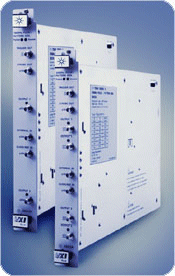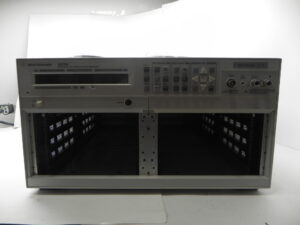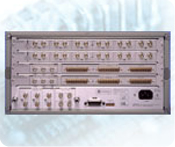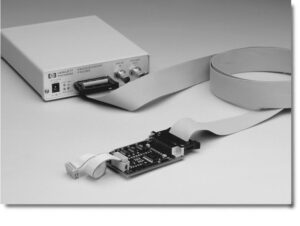equipment
Keysight E9300H E-Series Average Power Sensor, 10 MHz to 18 GHz
The Agilent E9300H power sensor is designed to measure complex digital modulation formats including those used in today’s wireless communication, satellite and cable TV systems. The E9300H can also measure both multi-tone and continuous-wave (CW) signals.
Read MoreKeysight E8312A Pulse/Pattern Generator, 330 MHz VXI C-1
The Agilent E8312A, 330 MHz VXI C-1 pulse/pattern generator can be used for a wide variety of applications including – functional verification of high-speed digital or mixed-signal devices – clock generation for synchronization of an automated test system – radar testing – flash memory test – serial bus testing The module offers highly accurate signals. The timing parameters can be adjusted for every amplitude or offset level to meet any specification. A fixed trigger-in to signal-out delay and variable delay ranges, enable highly reliable and stable synchronization of test systems even at very precise points in time, such as those used in radar testing. You can easily integrate the two new pulse/pattern generators into manufacturing test environments because the modules come equipped with VXIplug&play software drivers. Also, they are compatible with Agilent’s box pulse generators (81100 and 8110A), already used in many laboratories handling R&D and quality test applications, making it easy to transition test routines from lab to production site. Serial patterning capabilities at up to 16Kbits per channel permit you to simulate complex protocols, using pre-configured standard formats such as RZ, NRZ, DNRZ or PRBS. Pulse-width modulated signals, such as those used for testing regulating circuits, also can be easily programmed and emulated. Their variable transition times guarantee that rise and fall measurements are fully adjustable, thereby avoiding spikes, cross talk and ringing when logic designs are tested at low speeds (10 MHz to 100 MHz). Inverted outputs allow you to generate differential signals for testing high-speed (>100 MHz) buses based on LVDS (Low Voltage Differential Signaling) technology for other specialized computer and communications applications.
Read MoreKeysight E7475A GSM Based Drive Test Systems
A critical measure of the quality of a wireless network is the performance of the air interface. To understand how well service is delivered to subscribers you must characterize the performance of your network as a function of location. The Agilent E7475A GSM based drive test system collects RF measurement and call performance data versus location. It can be configured for both indoor and outdoor measurements for E-GSM900, DCS1800, GSM1900 and GSM-R networks. Up to four digital receivers and test mobile phones can be integrated in a single Windows software user interface.
Read MoreKeysight E5270A Parametric Measurement Mainframe, 8-slot
The Agilent E5270A, is an eight-slot user-configurable parametric measurement mainframe, which houses up to four HPSMUs or eight MPSMUs, creating a one-to-eight-channel test solution. The E5270A is ideal for testing RF devices, particularly monolithic microwave integrated circuits (MMICs), which require multiple DC bias sources on their non-RF pins during test. The E5270A can be configured with up to eight DC bias sources, reducing the overall number of touchdowns necessary to test MMIC wafers. The E5270A is also ideal for component characterization, where four or more SMUs are needed, or in situations where more than one HPSMU is required.
Read MoreKeysight E5255A 24 (8 x 3) Channel Multiplexer Card
The E5255A 24 (8×3) Channel Multiplexer is a 2-imput to 24-output multiplexer card for the Agilent E5250A Low Leakage Switch Mainframe. The E5255A consists of 3 blocks (three 2×8 multiplexers). One E5255A can be configured as three 2×8 multiplexers, a 2×16 multiplexer and a 2×8 multiplexer, or a 2×24 multiplexer. 2-input means one BIAS input and one IV input. The E5255A is designed for component device reliability testing which needs to automatically scan instrument input/output for many DUTs. A maximum of four E5255As can be installed in the E5250A.
Read MoreKeysight E4838A 675 MHz Data Generator Front End
The Agilent E4838A module is a data generator front end. 675 MHz, RZ/NRZ, single channel, differential, variable transition times, 3.5 Vpp. For use with the E4832A Data Generator/Analyzer module.
Read MoreKeysight E4832A 675 MHz Data Generator/Analyzer Module
The Agilent ParBERT 81250 675 Mb/s modules are the ideal solution for testing the parallel side of devices according to Gigabit Ethernet, Digital Video applications and up to OC-192 standards. The E4832A module is one VXI slot wide and can contain any combination of up to four E4838A Generator front-end plug-in cards and two E4835A Analyzer front-end plug-in cards. This module provides four slots for any mix of generator or analyzer front-ends, E4838A, E4835A. This module allows 4 independent channels with PRBS/PRWS measurements up to 215-1 and has a memory depth of up to 2 Mbit per channel.
Read MoreThe Agilent E4412A diode power sensor, with wide dynamic range, is designed for use with the EPM and EPM-P series power meters for power measurements on CW signals from 10 MHz to 18 GHz. The E4412A power sensor provides extremely low SWR to minimize the source and sensor mismatch errors. Also, for comprehensive error correction, the calibration factors, linearity and temperature error-correction information are stored in EEPROM. The sensor’s power measurements are traceable to the U.S. National Institute of Standards and Technology (NIST).
Read MoreThe E3458A processor probe provides an inexpensive way to control target microcontroller operation during the hardware and software development phases of Motorola CPU32-based prototypes. The processor probe controls the target microcontroller through the Motorola Background Mode Debug (BDM) port. Connection of a processor probe to a PC or workstation is made via LAN or RS-232.
Read More






